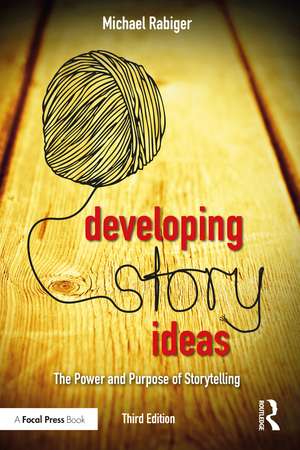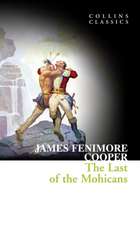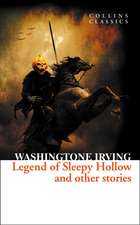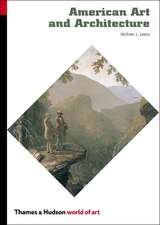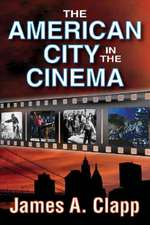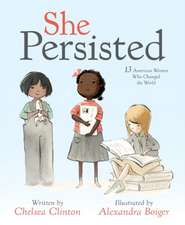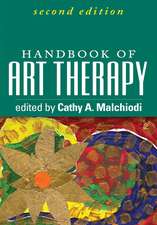Developing Story Ideas: The Power and Purpose of Storytelling
Autor Michael Rabigeren Limba Engleză Paperback – 21 iul 2016
This new edition has been updated with chapters on adaptation, improvisation, and cast collaboration’s roles in story construction, as well as a companion website featuring further projects, class assignments, instructor resources, and more.
- Gain the practical tools and resources you need to spark your creativity and generate a wide variety of stories in a broad range of forms, including screenplays, documentaries, novels, short stories, and plays
- Through hands-on, step-by-step exercises and group and individual assignments, learn to use situations and themes from your own life experience, dreams, myth, and the news as the basis for character-driven storytelling; harness methods of screenplay format, dialogue, plot structure, and character development that will allow your stories to reach their fullest potential
| Toate formatele și edițiile | Preț | Express |
|---|---|---|
| Paperback (2) | 117.60 lei 36-50 zile | |
| Taylor & Francis – 30 noi 2005 | 117.60 lei 36-50 zile | |
| Taylor & Francis – 21 iul 2016 | 279.62 lei 43-57 zile | |
| Hardback (1) | 1110.74 lei 43-57 zile | |
| Taylor & Francis – 19 iul 2016 | 1110.74 lei 43-57 zile |
Preț: 279.62 lei
Nou
Puncte Express: 419
Preț estimativ în valută:
53.52€ • 58.16$ • 44.99£
53.52€ • 58.16$ • 44.99£
Carte tipărită la comandă
Livrare economică 21 aprilie-05 mai
Preluare comenzi: 021 569.72.76
Specificații
ISBN-13: 9781138956230
ISBN-10: 1138956236
Pagini: 230
Dimensiuni: 152 x 229 x 15 mm
Greutate: 0.3 kg
Ediția:Revised
Editura: Taylor & Francis
Colecția Routledge
Locul publicării:Oxford, United Kingdom
ISBN-10: 1138956236
Pagini: 230
Dimensiuni: 152 x 229 x 15 mm
Greutate: 0.3 kg
Ediția:Revised
Editura: Taylor & Francis
Colecția Routledge
Locul publicării:Oxford, United Kingdom
Cuprins
Part I
OVERVIEW
Chapter 1: This Book, Its Goals, and Getting Started
You and Your Resources
Why We Work in Outline Form
Ideation and Originality
Identifying with the Main Character
Jump-Starting the Imagination
The Assignments
Concerning the Writing Samples
Having Fun
This Book’s Layout and Goals
Getting Started
The game called CLOSAT
Chapter 2: You and the Creative Process
The Journey of the Self
Wanting to Tell Stories
Self-Exposure and Giving Support
What is Therapy and What Is Art?
What Stories Mean
Theme and Variation
Just Do It
Outline and Expansion
Collaboration
Part II
SELF-EXAMINATION, OBSERVATION,
AND IMPROVISATION ASSIGNMENTS
Chapter 3: Artistic Identity
Displacement
Assignment 3-1: Survey of Yourself and Your Authorial Goals
Assignment 3-2: Presenting Yourself and Your Storytelling Goals
Assignment 3-3 Listening and Reacting
Going Farther
Chapter 4: Introductions and Playing "CLOSAT"
Improvising
Maintaining Focus
Pitching
If You are Working Alone
Assignment 4-1: Five-Minute Self-Introduction.
Assignment 4-2: Play the CLOSAT game.
Assignment 4-3: Develop your Own Pitching Guidelines.
General discussion
Chapter 5: Autobiography and Influences
Assignment 5-1: Autobiographical Survey
Assignment 5-2: Presenting your influences.
Chapter 6: Observing from Life
Assignment 6-1: CLOSAT preparatory work and the writer’s journal
Assignment 6-2: CLOSAT with 2 characters, 1 location and 1 Object
Assignment 6-3: CLOSAT with 3 Characters, 2 objects, an act and a theme
Going Farther
Assignment 6-4: CLOSAT Variations for a Group/Class
The Power of Imagery.
Going Farther
Part III
USING THE TOOLS OF DRAMA
Chapter 7: Developing Your Characters and the Dramatist’s Toolkit
Checklist for Developing Your Characters
The Tools of the Dramatist
Tools #1–4, Four Hats
Tool #5, the Questionnaire
Tool #6, the Diving Mask
Tool #7, the Key (the Dramatic Premise)
Tool #8, the Pressure Meter (Detects and Measures Conflict)
Tool #9, the Stopwatch (Represents Time Progressing)
Tool #10, the Cake Slice (Separates Drama into its Components)
Tool #11, the Set of Boxes (Representing the Three-Act Structure.)
Tool #12, the Telescope (Finding Point of View)
Chapter 8: Analyzing a Scene
Using tool #5, the Questionnaire
Using tool #6, the Diving Mask.
Using tool #7, the Key (finding a dramatic premise)
Using tool #8, the Pressure Meter (Detects and Measures Conflict)
Using tool #9, the Stopwatch (Represents Time Progressing)
An Analogy for Drama
Using tool # 10, the Cake-Slice (Separating Drama into its Components)
Assignment 8-1: Character and Destiny
Assignment 8-2: Volition and Point of View
Assignment 8-3: Acting on volition.
Assignment 8-4: Scene Divisions for "The Fisherman’s Wife."
The Fisherman’s Wife
Chapter 9: Assessing a Complete Work
Using tool #11, the Set of Boxes
The Three-Act Structure.
Character Driven versus Plot Driven Drama
Using tool #8, the Pressure Meter Again (Sources of Pressure, Identifying Genre)
Drawing a Dramatic Arc for a Whole Work
Drama and Point of View
Assignment 9-1: Dividing "Little Red Riding Hood" into Scenes and Acts.
Assignment 9-2 Character Types and Story Meanings.
Going Farther
Chapter 10: Testing a Story Idea and Deciding Point of View
Exploring a Story’s Effectiveness
Story Effectiveness Questionnaire
Exploring a Story’s Meaning and Purpose
Story Editing Tools in Summary
Assignment 10-1: Impressions and Feedback.
Assignment 10-2: Critical Communication.
Part IV:
CREATIVE WRITING ASSIGNMENTS
Chapter 11: A Tale from Childhood
On Discussion
Assignment 11-1: An Event from Childhood
Assignment 11-1: An Event from Childhood
Assignment 11-3 Developing a childhood film or photo scene.
Example 1 (Vilka Tzouras)
Example 2 (Alex Meillier)
Example 3 (Chris Darner)
Example 4 (Amanda McCormick)
Discussion
On memory
Going Farther
Chapter 12: Family Story
Assignment 12-1: A Story Told in Your Family
Assignment 12-2 Family Story as Comic Strip
Assignment 12-3 The Untold Story
Discussion
Example 1 (Margaret Harris)
Example 2 (Amanda McCormick)
Example 3 (Peter Riley)
Going Farther
Chapter 13: A Myth, Legend, or Folktale Retold
Interpreting Oral Tales
Adaptation Problems
Assignment 13-1 Free Choice of Tale.
Assignment 13-2 Myth
Assignment 13-3 Legend
Assignment 13-4 Folktale
Discussion
Example #1: The Legend of Pretty Boy Floyd Retold (Michael Hanttula)
Example #2 (Tatsuya Guillermo Ohno)
Example #3: Sisyphus Cries Dixie: A Modern Story (Michelle Arnove)
Discussion
Going Farther
Chapter 14: Dream Story
Assignment 14-1: Writing up a Dream
Assignment 14-2: Surreal Narrative
Assignment 14-3: Linking Dreams into One Narrative
Assignment 14-4 Dream and Myth
Discussion
Dream Sequence #1 (Chris Darner)
Dream Sequence #2 (Michael Hanttula)
Dream Sequence #3 (Cynthia Merwarth)
Going Farther
Chapter 15: Adapting a Short Story
Evaluating a Story for Adaptation to the Screen
Assignment 15-1: Short Story Analysis
Assignment 15-2: Adaptation Issues
Assignment 15-3: Dramatic Breakdown
Discussion
Example 1: "An Encounter," from Dubliners, by James Joyce (Peter Riley)
Example 2, "Le Diner de Cons," by Francis Veber (Louis Leterrier)
Overview
Going Farther
Chapter 16: Ten-Minute, News Inspired Story
Making a Working Hypothesis
Assignment 16-1: A picture and its consequences.
Assignment 16-2: Reality TV show.
Assignment 16-3: Docudrama.
Assignment 16-4: Based on a Real Story...
Assignment 16-5: Behind the Façade
Assignment 16-6: This Far, and No Farther
Assignment 16-7: Analyze Four News Items.
Assignment 16-8: Develop Interpersonal Difference
Discussion
Going Farther
Chapter 17: A Documentary Subject
Assignment 17-1: A Documentary Subject
Assignment 17-2: Simple Voice-Over Personal Film
Assignment 17-3: Simple Voice-Over Historical Film
Documentary Subject (Angela Galyean)
Going Farther
Chapter 18: Thirty-Minute Original Fiction
Assignment 18-1: Treatment for an Original Thirty-Minute Fiction Piece.
Assignment 18-2: An Original 30-minute Fiction Piece Inspired by an Image.
Assignment 18-3: An Original 30-minute Fiction Piece Inspired by CLOSAT Cards.
Assignment 18-3: An Original 30-minute Fiction Piece Inspired by CLOSAT Cards.
Example #1: Thirty-Minute Original Fiction Idea (Michael Hanttula)
Example #2: "Eggs Benedict" (Michelle Arnove)
On Comedy
Going Farther
Chapter 19: Feature Film
Assignment 19-1: Idea for a Feature Film (Featuring Two Points of View)
Example: Feature Film Idea (Paul Flanagan)
On The Writing Process and Receiving Criticism
Going Farther
Part VCOLLABORATIVE STORY DEVELOPMENT
Chapter 20: Wholly Improvised (Scenes and story construction in the vein of Cassavetes, Fassbinder, Linklater)
Chapter 21: Screenplay generated from Improvisation (Screenplay generated from a core of ideas, cast collaboration and improvisations, then best material transcribed and shaped into a screenplay, in the vein of Bergman, Leigh)
Part V
THE EMERGING WRITER
Chapter 22: Revisiting Your Artistic Identity
Your Creative Direction
Assignment 20-1: Revisiting your Artistic Identity.
Assignment 20-2: Say Where You’d Like to Go.
Assignment 20-3: Ideas and Ambitions.
Assignment 20-4 Setting a Personal Agenda.
Discussion and Retrospective
Part VI:
EXPANDING YOUR WORK INTO ITS FINAL FORM
Chapter 23: Story-Editing Your Outline
Structural Options
Transitions
Stream of Consciousness
Troubleshooting
Yielding to the Dramatic Conventions
Chapter 24: Expanding Your Outline
Writing for the Screen
Standard Screenplay Format
Camera and Editing Directions
Sound and Music Directions
Documentary Film Proposal
Plays
Standard Playwriting Format
Novel or Short Story Format
OVERVIEW
Chapter 1: This Book, Its Goals, and Getting Started
You and Your Resources
Why We Work in Outline Form
Ideation and Originality
Identifying with the Main Character
Jump-Starting the Imagination
The Assignments
Concerning the Writing Samples
Having Fun
This Book’s Layout and Goals
Getting Started
The game called CLOSAT
Chapter 2: You and the Creative Process
The Journey of the Self
Wanting to Tell Stories
Self-Exposure and Giving Support
What is Therapy and What Is Art?
What Stories Mean
Theme and Variation
Just Do It
Outline and Expansion
Collaboration
Part II
SELF-EXAMINATION, OBSERVATION,
AND IMPROVISATION ASSIGNMENTS
Chapter 3: Artistic Identity
Displacement
Assignment 3-1: Survey of Yourself and Your Authorial Goals
Assignment 3-2: Presenting Yourself and Your Storytelling Goals
Assignment 3-3 Listening and Reacting
Going Farther
Chapter 4: Introductions and Playing "CLOSAT"
Improvising
Maintaining Focus
Pitching
If You are Working Alone
Assignment 4-1: Five-Minute Self-Introduction.
Assignment 4-2: Play the CLOSAT game.
Assignment 4-3: Develop your Own Pitching Guidelines.
General discussion
Chapter 5: Autobiography and Influences
Assignment 5-1: Autobiographical Survey
Assignment 5-2: Presenting your influences.
Chapter 6: Observing from Life
Assignment 6-1: CLOSAT preparatory work and the writer’s journal
Assignment 6-2: CLOSAT with 2 characters, 1 location and 1 Object
Assignment 6-3: CLOSAT with 3 Characters, 2 objects, an act and a theme
Going Farther
Assignment 6-4: CLOSAT Variations for a Group/Class
The Power of Imagery.
Going Farther
Part III
USING THE TOOLS OF DRAMA
Chapter 7: Developing Your Characters and the Dramatist’s Toolkit
Checklist for Developing Your Characters
The Tools of the Dramatist
Tools #1–4, Four Hats
Tool #5, the Questionnaire
Tool #6, the Diving Mask
Tool #7, the Key (the Dramatic Premise)
Tool #8, the Pressure Meter (Detects and Measures Conflict)
Tool #9, the Stopwatch (Represents Time Progressing)
Tool #10, the Cake Slice (Separates Drama into its Components)
Tool #11, the Set of Boxes (Representing the Three-Act Structure.)
Tool #12, the Telescope (Finding Point of View)
Chapter 8: Analyzing a Scene
Using tool #5, the Questionnaire
Using tool #6, the Diving Mask.
Using tool #7, the Key (finding a dramatic premise)
Using tool #8, the Pressure Meter (Detects and Measures Conflict)
Using tool #9, the Stopwatch (Represents Time Progressing)
An Analogy for Drama
Using tool # 10, the Cake-Slice (Separating Drama into its Components)
Assignment 8-1: Character and Destiny
Assignment 8-2: Volition and Point of View
Assignment 8-3: Acting on volition.
Assignment 8-4: Scene Divisions for "The Fisherman’s Wife."
The Fisherman’s Wife
Chapter 9: Assessing a Complete Work
Using tool #11, the Set of Boxes
The Three-Act Structure.
Character Driven versus Plot Driven Drama
Using tool #8, the Pressure Meter Again (Sources of Pressure, Identifying Genre)
Drawing a Dramatic Arc for a Whole Work
Drama and Point of View
Assignment 9-1: Dividing "Little Red Riding Hood" into Scenes and Acts.
Assignment 9-2 Character Types and Story Meanings.
Going Farther
Chapter 10: Testing a Story Idea and Deciding Point of View
Exploring a Story’s Effectiveness
Story Effectiveness Questionnaire
Exploring a Story’s Meaning and Purpose
Story Editing Tools in Summary
Assignment 10-1: Impressions and Feedback.
Assignment 10-2: Critical Communication.
Part IV:
CREATIVE WRITING ASSIGNMENTS
Chapter 11: A Tale from Childhood
On Discussion
Assignment 11-1: An Event from Childhood
Assignment 11-1: An Event from Childhood
Assignment 11-3 Developing a childhood film or photo scene.
Example 1 (Vilka Tzouras)
Example 2 (Alex Meillier)
Example 3 (Chris Darner)
Example 4 (Amanda McCormick)
Discussion
On memory
Going Farther
Chapter 12: Family Story
Assignment 12-1: A Story Told in Your Family
Assignment 12-2 Family Story as Comic Strip
Assignment 12-3 The Untold Story
Discussion
Example 1 (Margaret Harris)
Example 2 (Amanda McCormick)
Example 3 (Peter Riley)
Going Farther
Chapter 13: A Myth, Legend, or Folktale Retold
Interpreting Oral Tales
Adaptation Problems
Assignment 13-1 Free Choice of Tale.
Assignment 13-2 Myth
Assignment 13-3 Legend
Assignment 13-4 Folktale
Discussion
Example #1: The Legend of Pretty Boy Floyd Retold (Michael Hanttula)
Example #2 (Tatsuya Guillermo Ohno)
Example #3: Sisyphus Cries Dixie: A Modern Story (Michelle Arnove)
Discussion
Going Farther
Chapter 14: Dream Story
Assignment 14-1: Writing up a Dream
Assignment 14-2: Surreal Narrative
Assignment 14-3: Linking Dreams into One Narrative
Assignment 14-4 Dream and Myth
Discussion
Dream Sequence #1 (Chris Darner)
Dream Sequence #2 (Michael Hanttula)
Dream Sequence #3 (Cynthia Merwarth)
Going Farther
Chapter 15: Adapting a Short Story
Evaluating a Story for Adaptation to the Screen
Assignment 15-1: Short Story Analysis
Assignment 15-2: Adaptation Issues
Assignment 15-3: Dramatic Breakdown
Discussion
Example 1: "An Encounter," from Dubliners, by James Joyce (Peter Riley)
Example 2, "Le Diner de Cons," by Francis Veber (Louis Leterrier)
Overview
Going Farther
Chapter 16: Ten-Minute, News Inspired Story
Making a Working Hypothesis
Assignment 16-1: A picture and its consequences.
Assignment 16-2: Reality TV show.
Assignment 16-3: Docudrama.
Assignment 16-4: Based on a Real Story...
Assignment 16-5: Behind the Façade
Assignment 16-6: This Far, and No Farther
Assignment 16-7: Analyze Four News Items.
Assignment 16-8: Develop Interpersonal Difference
Discussion
Going Farther
Chapter 17: A Documentary Subject
Assignment 17-1: A Documentary Subject
Assignment 17-2: Simple Voice-Over Personal Film
Assignment 17-3: Simple Voice-Over Historical Film
Documentary Subject (Angela Galyean)
Going Farther
Chapter 18: Thirty-Minute Original Fiction
Assignment 18-1: Treatment for an Original Thirty-Minute Fiction Piece.
Assignment 18-2: An Original 30-minute Fiction Piece Inspired by an Image.
Assignment 18-3: An Original 30-minute Fiction Piece Inspired by CLOSAT Cards.
Assignment 18-3: An Original 30-minute Fiction Piece Inspired by CLOSAT Cards.
Example #1: Thirty-Minute Original Fiction Idea (Michael Hanttula)
Example #2: "Eggs Benedict" (Michelle Arnove)
On Comedy
Going Farther
Chapter 19: Feature Film
Assignment 19-1: Idea for a Feature Film (Featuring Two Points of View)
Example: Feature Film Idea (Paul Flanagan)
On The Writing Process and Receiving Criticism
Going Farther
Part VCOLLABORATIVE STORY DEVELOPMENT
Chapter 20: Wholly Improvised (Scenes and story construction in the vein of Cassavetes, Fassbinder, Linklater)
Chapter 21: Screenplay generated from Improvisation (Screenplay generated from a core of ideas, cast collaboration and improvisations, then best material transcribed and shaped into a screenplay, in the vein of Bergman, Leigh)
Part V
THE EMERGING WRITER
Chapter 22: Revisiting Your Artistic Identity
Your Creative Direction
Assignment 20-1: Revisiting your Artistic Identity.
Assignment 20-2: Say Where You’d Like to Go.
Assignment 20-3: Ideas and Ambitions.
Assignment 20-4 Setting a Personal Agenda.
Discussion and Retrospective
Part VI:
EXPANDING YOUR WORK INTO ITS FINAL FORM
Chapter 23: Story-Editing Your Outline
Structural Options
Transitions
Stream of Consciousness
Troubleshooting
Yielding to the Dramatic Conventions
Chapter 24: Expanding Your Outline
Writing for the Screen
Standard Screenplay Format
Camera and Editing Directions
Sound and Music Directions
Documentary Film Proposal
Plays
Standard Playwriting Format
Novel or Short Story Format
Recenzii
"Whenever a book’s lifespan makes it through several editions, you know that it must be doing something right...Now in it’s third edition, Michael Rabiger’s Developing Story Ideas serves an area of creative development which is normally not addressed in most storytelling/screenwriting manuals; how to come up with an idea for a story in the first place."
--Jonny Elwyn, freelance film editor and creator of jonnyelwyn.co.uk
--Jonny Elwyn, freelance film editor and creator of jonnyelwyn.co.uk
Descriere
The vast majority of screenplay and writing books that focus on story development have little to say about the initial concept that inspired the piece. Developing Story Ideas: The Power and Purpose of Storytelling, Third Edition provides writers with ideational tools and resources to generate a wide variety of stories in a broad range of forms. Celebrated filmmaker and author Michael Rabiger demonstrates how to observe situations and themes in the writer’s own life experience, and use these as the basis for original storytelling.
This new edition has been updated with chapters on adaptation, improvisation, and cast collaboration’s roles in story construction, as well as a companion website featuring further projects, class assignments, instructor resources, and more.
This new edition has been updated with chapters on adaptation, improvisation, and cast collaboration’s roles in story construction, as well as a companion website featuring further projects, class assignments, instructor resources, and more.
Notă biografică
Michael Rabiger has directed or edited over 35 films, founded the Documentary Center at Columbia College, Chicago, and was Chair of its Film/Video Department. Now Professor Emeritus, Rabiger has also been presented with the Preservation and Scholarship Award by the International Documentary Association. He has given workshops in many countries, led a multinational European documentary workshop for CILECT, the international association of film schools. As Visiting Professor at New York University's Tisch School of the Arts, he taught idea development, directing, and advanced production. When he retired 2001 to write full-time, Columbia renamed its documentary center "The Michael Rabiger Center for Documentary." In 2002 he was made Honorary Professor at the University of Buenos Aires, Argentina; in 2003 awarded the 2003 Preservation and Scholarship Award by the International Documentary Association in Los Angeles; in 2005 the Genius Career Achievement Award by the Chicago International Documentary Festival, and also in 2005 was made Professor Emeritus by Columbia College Chicago. He is the author of the enormously successful, Directing: Film Techniques and Aesthetics (Focal Press), now in its fourth edition, and Directing the Documentary (Focal Press), now in its fifth edition. He is also the author of Developing Story Ideas (Focal Press), currently in its second edition. He is currently writing a biography of Thomas Hardy.
